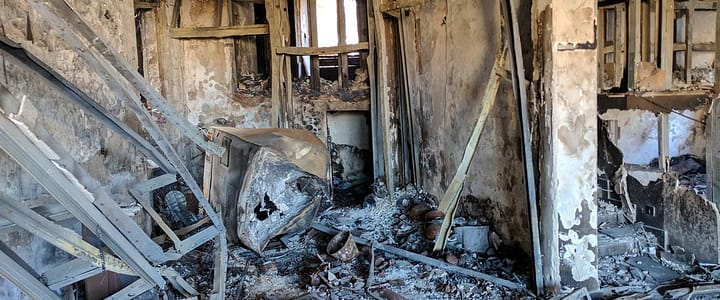Fires can wreak havoc on homes and properties, leaving behind a trail of destruction that varies in nature and severity. To effectively address the aftermath of a fire, it’s crucial to understand the different types of fire damage. When I sell my fire damaged house, I will need to know exactly what type of damage has occurred to address it properly. In this article, we’ll explore the various categories of fire damage and how they impact homes and property.

Structural Damage
Structural damage is one of a fire’s most severe and immediate consequences. It affects the integrity of the building and includes:
- Burned Support Beams and Columns: The heat from a fire can weaken or destroy the structural support of a building, which poses a severe safety risk.
- Roof Damage: The intense heat can cause the roof to weaken and potentially collapse, leading to further damage and exposure to the elements.
- Wall Damage: Fire can breach walls, compromising the stability of the structure.
- Foundation Damage: The foundation may crack or become unstable due to extreme heat or structural shifting.
Water Damage
Water damage is another significant consequence of fires, as water is often used to extinguish the flames. This type of damage includes:
- Saturated Materials: Water can soak into carpets, furniture, and drywall, causing them to warp or become irreparably damaged.
- Mold Growth: The excess moisture from water damage creates a breeding ground for mold growth, posing health hazards if not properly remediated.
- Structural Damage: As mentioned earlier, water damage can also lead to further structural damage if it weakens the building’s support or foundation.
Smoke Damage
Smoke damage often accompanies fires and can be pervasive throughout the property. It includes:
- Residue and Soot: Smoke leaves behind a layer of soot and residue on walls, ceilings, and surfaces. This can be challenging to remove and can cause discoloration and odors.
- Smoke Stains: Smoke can stain various surfaces and materials, making it challenging to restore their original appearance.
Electrical Damage
Fires can cause significant electrical damage, posing a safety hazard for homeowners and professionals handling the aftermath. This type of damage includes:
- Burned Wiring: The heat from a fire can melt or destroy electrical wiring, rendering it unsafe and in need of repair or replacement.
- Damaged Appliances: Electrical fires can also damage appliances and other electronic devices, making them unusable.
- Circuit Breaker Damage: In severe cases, the intense heat from a fire can cause circuit breakers to malfunction or fail completely. This not only impacts the property’s electrical system but also poses a potential fire risk.
In Conclusion
Understanding the different types of fire damage is essential for effectively addressing the aftermath of a fire. Whether it’s structural damage, smoke and odor issues, water damage, or other consequences, each type requires a tailored approach for restoration and remediation. It’s crucial to work with professionals who specialize in fire damage assessment and restoration to ensure that your property is safely and fully restored to its pre-fire condition.

